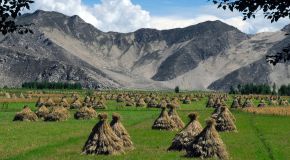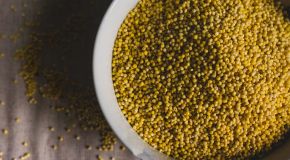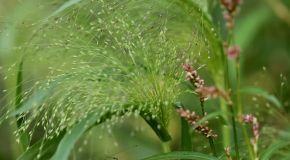Cereal variety:
A comprehensive comparison with millet as a healthy alternative

In the world of cereals, millet occupies a unique position. To understand the full picture, let's take a look at how it compares to other prominent cereals. From the well-known wheat varieties to the more exotic pseudo-cereals: What are the differences in nutritional content, cultivation and intended use? Let's explore the diversity of cereal crops and see why millet often stands out as a healthy alternative.
1. wheat: The classic with gluten:
Nutrient content: wheat is a major source of fiber and contains protein, vitamins and minerals. However, wheat also contains gluten, which can be problematic for people with gluten intolerance or coeliac disease.
Uses: Wheat is used in a variety of products around the world, from bread and pasta to baked goods and cereal products.
2. rice: The global staple:
Nutrient content: rice is high in carbohydrates, but somewhat low in protein and fiber compared to millet. Whole grain rice contains more nutrients than polished rice.
Uses: Rice is a staple food in many cultures and is used in a wide range of dishes, from main meals to desserts.
3. oats: The flakes for health:
Nutrient content: oats are particularly rich in soluble fiber, beta-glucans, which can lower cholesterol. Oats also contain proteins, vitamins and minerals.
Uses: Oat flakes are popular for breakfast porridge, muesli and baked goods. Oatmeal is also used in various recipes.
4. quinoa: The pseudo-cereal with superpowers:
Nutritional content: quinoa is a pseudocereal that is considered a complete protein. It contains all nine essential amino acids, making it an excellent plant-based source of protein.
Uses: Quinoa is often used as a side dish or main course in salads, soups and stir-fries. Its versatility makes it a popular choice for health-conscious eaters.
5. barley: tradition meets health:
Nutritional content: barley is rich in fiber, vitamins and minerals. It also contains beta-glucans, which can lower cholesterol levels.
Use: Barley is often used in soups, stews and as a side dish. Barley flour is also used in baked goods.
6. corn: Versatile and nutritious:
Nutrient content: Corn is rich in carbohydrates and fiber. It also contains vitamins and minerals, including vitamin C and magnesium.
Uses: Corn is consumed in many forms, from whole kernels to cornmeal to corn syrup. It is a key ingredient in many dishes worldwide.
7 Buckwheat: The ancient superfood:
Nutrient content: buckwheat is gluten-free and rich in protein, fiber, vitamins and minerals. It also contains rutin, an antioxidant.
Uses: Buckwheat is often made into porridge, muesli, pancakes and pasta. Its versatile nature makes it a healthy option.
8. spelt: The original alternative:
Nutritional content: spelt contains protein, fiber, vitamins and minerals. Compared to modern wheat, spelt can have a slightly higher nutrient density.
Uses: Spelt is used in bread, pasta and baked goods. It is a popular choice for those looking for an alternative to wheat.
Millet in comparison:
Nutritional content: millet is characterized by its high nutritional content, including protein, fiber, vitamins and minerals. Its gluten-free nature makes it particularly appealing to people with gluten intolerance.
Uses: Millet is extremely versatile and can be enjoyed in various forms. Whether as whole grains, flakes, flour or as the main ingredient in millet products - it can be used in a wide range of ways.
Comparative analysis:
Nutrient profile:
Millet stands out as it offers an impressive amount of essential nutrients. Its high levels of protein, fiber, B vitamins, iron and magnesium make it a nutritionally valuable choice. Compared to some other grains, millet scores particularly well due to its balanced nutrient composition.
Gluten-free:
While wheat and spelt contain gluten, millet is naturally gluten-free. This characteristic makes millet an ideal option for people with coeliac disease or gluten intolerance. Quinoa is another gluten-free alternative, however, millet's variety of gluten-free options can be surpassed by its various preparation forms and products.
Protein content:
Quinoa is often praised as a superfood for its high protein content. In fact, quinoa is one of the few plant sources that contains all the essential amino acids. Millet may be slightly lower in protein, but it is still a significant plant-based protein source and can compete well with other grains.
Fiber:
Oats have a reputation for being high in fiber, particularly soluble fiber, which is beneficial for gut health. However, millet also has a considerable fiber content, which can have a positive effect on digestion and satiety.
Minerals:
Barley and spelt are known for their content of minerals such as magnesium and iron. Millet, on the other hand, can also keep up here, with its magnesium content being particularly noteworthy. Magnesium is crucial for numerous bodily functions, including muscle and nerve function.
Practical applications:
Breakfast options:
Oats and millet are both excellent bases for nutritious breakfast dishes. Oatmeal is popular in many cultures, but millet flakes offer a gluten-free alternative and are a good choice for people looking for variety.
Bread and baked goods:
Wheat and spelt have traditionally dominated the world of bread and baked goods. However, millet flour is gaining popularity, especially in gluten-free recipes. Millet bread and pastries offer a tasty alternative for people who need or want to avoid gluten.
Side dishes and main courses:
Rice, barley and quinoa are well-known side dishes and main ingredients in many dishes. Millet is in no way inferior to them and can be used just as well in soups, stews, stir-fries and salads.
Healthy snacking:
Corn and oats may dominate in the snacking world, but roasted millet, millet chips and other millet snacks offer a crunchy and healthy alternative. Their fiber provides a long-lasting feeling of satiety, making them a smart choice.
Conclusion:
Take advantage of the variety that millet offers:
A comparison with other grains makes it clear that millet is not only a healthy option, but also an extremely versatile one. Its nutritional richness, gluten-free nature and ability to be enjoyed in a variety of forms make it a serious contender in the world of cereal crops. Whether as a main component of meals, as a side dish or as a base for tasty snacks, millet has undoubtedly earned its place on the plate. As a consumer, you have the opportunity to explore the variety of grains and choose the ones that best suit your taste preferences and health needs. After all, in the culinary world, variety is the key to a balanced and delicious approach to nutrition.





